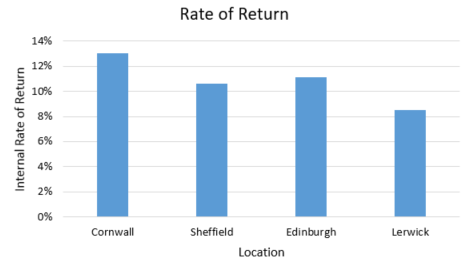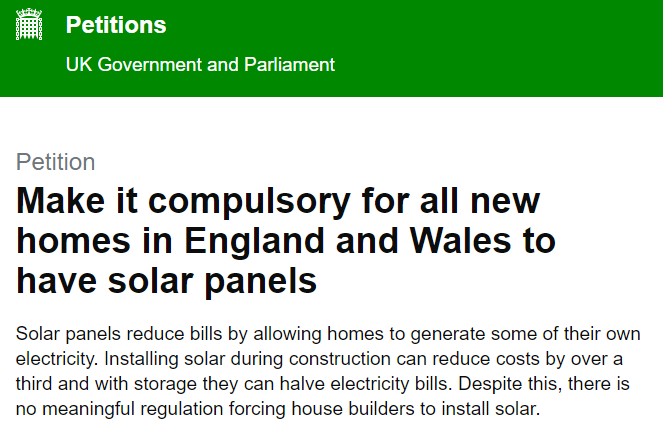In 2018, I have been running a petition on the UK Parliament website asking for a Parliamentary Debate that every new home in the UK should be installed with solar panels. I still believe that solar on all new build homes should be mandatory through building regulations to ensure that all new homes save money from day one on their energy bills. As a new build home, the costs of installation of solar are minimised and the payback would be short for most UK homes. Building firms follow regulations and this would be the correct way to implement the policy. Having worked myself with the Microgeneration Certification Scheme (MCS) on their standards and calculators, I know that the savings are real and significant.
You can find the petition here.
https://petition.parliament.uk/petitions/218223
And my press release is here:
Petition for Solar on all New Homes
Why should solar be mandatory on all new build homes?
The reasons for doing so are threefold:
- Through my years working with solar and batteries I know that they can save people money and the economics of solar and batteries gets better every year.
- Installing solar on a new home is cheaper than retrofitting them because it reduces the cost of sale, allows components to be bought in bulk and there is already safe roof access with scaffolding. Reducing the cost offers the best value for home owners and renters, both rich and poor.
- As shown with the EPC standards for homes, building companies need to be regulated if they are to install any energy saving equipment which benefits householders.
To make the case for this, I thought it best to share some insights from my PhD on solar PV pricing and the returns it could bring over 25 years (the duration of the manufacturers warranty for solar panels).
Saving people money
A simple calculation for Sheffield would be as follows:
- An average system (3.6kWh or 12 panels) will generate 2,875 kWh per year in Sheffield according to calculations from the UK certification scheme for microgeneration (the MCS). A link to their calculator is in my assumptions below.
- According to research conducted by Loughborough University, 47% of this will be consumed by the house (for a family home half of the day). This consumption reduces the homes electricity bill and the rest is exported to the grid to reduce national carbon emissions.
- All of my price and modelling assumptions are given at the end of the blog. The calculation is based on average values and publically available information.
If we do a quick calculation over 25 years to give a return and a payback period, we find some pretty impressive results due to the savings brought about by installing solar on a new build home. I’ve done this for four cities in the UK.
Cornwall: 9 year payback, 13% return
Sheffield: 10 year payback, 11% return
Edinburgh: 10 year payback, 11% return
Lerwick: 13 year payback, 9% return

The Building Industry Needs Regulation
With tens of thousands of homes being built in Britain, there will always be variations which mean the economics above are better for some and worse for others:
- To ensure value for money for all: I would like to see the policy implemented in such a way that each new home has to undergo a cost-benefit analysis using a nationally recognised and enforced calculator. If the returns of that analysis are above a threshold return (9%) and a 10 year payback then the house builder should be mandated to add solar panels. This shall be submitted as part of the planning process. Homes that don’t meet that criteria won’t have to have solar installed.
- To ensure meaningful system sizes, builders would be mandated to install 3.6kW or within 20% of the maximum number of panels that can be installed within the national returns model (whichever is lowest).
- The installs shall be completed in accordance with the Microgeneration Scheme and the calculator administered by MCS or Ofgem.
- The calculator will of course account for shading and local weather (as is standard for all UK installs completed under MCS) and use a standard price model.
There are already recognised and well managed calculators for energy saving in homes (e.g. the SAP calculation) with mechanisms to assure compliance. This is just an extension of the above.
Cheaper than Retrofitting
Ultimately, installing solar on a new home is usually cheaper than retrofitting it after a family moves in. It’s a great opportunity to save money on the installation cost and to start saving money from the day the home is occupied.
Conclusions
I think this result is quite clear:
- The payback period is good and the internal rate of return is strong
- Over 25 years, this saves a family over £8,000 of electricity.
- The system adds less than 1.4% (£3,000) to the price of a UK home before savings in roofing are considered.
What you can do to help
If you believe in this petition, I ask that you share it widely and gain support. This petition will work with grass roots support, from people like you using their networks to spread the message and from you making the case to others (if you agree with me).
I will be releasing a series of blogs over the next few weeks, responding to questions and answering any criticisms that come up plus some work on storage too. Having studied and worked on this issue for 6 years now, I felt wrong not to share my knowledge with you.
Share this link: https://petition.parliament.uk/petitions/218223
Assumptions
In the above, I made the following assumptions
- Homes pay 12p/kWh for electricity and electricity price inflation is 5% per annum
- Solar electricity not consumed in the home is automatically sold to the grid at 5p/kWh at a 2.3% inflation rate via a smart meter or deemed export rate.
- The solar panels are unshaded 95% of the time
- I have not accounted any savings of using solar roof tiles etc. which replace actual roof tiles and reduce the cost of the build BUT I have included an estimate of the engineer to install the panels.
- I’ve carried out a survey of retailers to get an average install price for solar PV on a UK home. I then estimated that 30% of this price is lost on a new build home due to the cost of sale, the margins of the retailers and that a house builder can buy in bulk with a big solar company to reduce the cost of key components.
- I have included replacement of the solar inverter at the end of it’s warranty (10 years). I don’t include any other maintenance costs, because there are hardly any.
- Economic benefits of carbon saving are not calculated, although these can be found at https://www.gov.uk/government/collections/carbon-valuation–2
- I don’t include any subsidy in the form of a generation tariff.
- My homes don’t have electric heating or air conditioning – either of which improve the savings.
- I use a model from Loughborough University to assess the amount of solar consumed on site each year. The amount increases by 0.5% per year as customers get better at using solar and electrify heat and transport.
- Solar PV generation is calculated for a 30degree roof using MCS standard performance calculations https://www.microgenerationcertification.org/mcs-standards/installer-standards/solar-pv/
Further Reading
http://www.lse.ac.uk/GranthamInstitute/news/do-green-mortgages-work/

